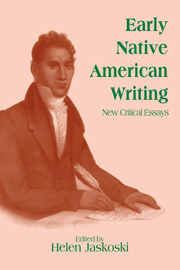Book contents
- Frontmatter
- Contents
- Foreword
- Preface
- List of Contributors
- 1 “Honoratissimi benefactores” Native American students and two seventeenth-century texts in the university tradition
- 2 “Pray Sir, consider a little”: Rituals of subordination and strategies of resistance in the letters of Hezekiah Calvin and David Fowler to Eleazar Wheelock
- 3 “(I speak like a fool but I am constrained)”: Samson Occom's Short Narrative and economies of the racial self
- 4 “Where, then, shall we place the hero of the wilderness?”: William Apess's Eulogy on King Philip and doctrines of racial destiny
- 5 “They ought to enjoy the home of their fathers”: The treaty of 1838, Seneca intellectuals, and literary genesis
- 6 “I am Joaquin!”: Space and freedom in Yellow Bird's The Life and Adventures of Joaquin Murieta, the Celebrated California Bandit
- 7 “This voluminous unwritten book of ours”: Early Native American writers and the oral tradition
- 8 “A terrible sickness among them”: Smallpox and stories of the frontier
- 9 “A desirable citizen, a practical business man”: G. W. Grayson – Creek mixed blood, nationalist, and autobiographer
- 10 “An Indian … An American”: Ethnicity, assimilation, and balance in Charles Eastman's From the Deep Woods to Civilization
- 11 “Overcoming all obstacles”: The assimilation debate in Native American women's journalism of the Dawes era
- 12 “My people … my kind”: Mourning Dove's Cogewea, The Half-Blood as a narrative of mixed descent
- 13 “Because I understand the storytelling art”: The evolution of D'Arcy McNickle's The Surrounded
13 - “Because I understand the storytelling art”: The evolution of D'Arcy McNickle's The Surrounded
Published online by Cambridge University Press: 20 February 2010
- Frontmatter
- Contents
- Foreword
- Preface
- List of Contributors
- 1 “Honoratissimi benefactores” Native American students and two seventeenth-century texts in the university tradition
- 2 “Pray Sir, consider a little”: Rituals of subordination and strategies of resistance in the letters of Hezekiah Calvin and David Fowler to Eleazar Wheelock
- 3 “(I speak like a fool but I am constrained)”: Samson Occom's Short Narrative and economies of the racial self
- 4 “Where, then, shall we place the hero of the wilderness?”: William Apess's Eulogy on King Philip and doctrines of racial destiny
- 5 “They ought to enjoy the home of their fathers”: The treaty of 1838, Seneca intellectuals, and literary genesis
- 6 “I am Joaquin!”: Space and freedom in Yellow Bird's The Life and Adventures of Joaquin Murieta, the Celebrated California Bandit
- 7 “This voluminous unwritten book of ours”: Early Native American writers and the oral tradition
- 8 “A terrible sickness among them”: Smallpox and stories of the frontier
- 9 “A desirable citizen, a practical business man”: G. W. Grayson – Creek mixed blood, nationalist, and autobiographer
- 10 “An Indian … An American”: Ethnicity, assimilation, and balance in Charles Eastman's From the Deep Woods to Civilization
- 11 “Overcoming all obstacles”: The assimilation debate in Native American women's journalism of the Dawes era
- 12 “My people … my kind”: Mourning Dove's Cogewea, The Half-Blood as a narrative of mixed descent
- 13 “Because I understand the storytelling art”: The evolution of D'Arcy McNickle's The Surrounded
Summary
Has Morgan the right to take my child from me when I want to raise him as white man, and fit him for a better lot in Life, than the common indian?
Philomene McNickleD'Arcy McNickle, who was born on the Flathead Reservation in 1904, was ten years old when his mother wrote this letter to the Commissioner of Indian Affairs in a futile attempt to regain custody of her three children, especially of her son, after her divorce from her white husband, William McNickle. Even though she was unsuccessful and D'Arcy McNickle had to remain in Chemawa, the Indian boarding school, for four years, her wish to “raise him as white man” determined his life until 1934, when financial necessity and a growing sense of himself as Indian led McNickle to apply for a position in the Bureau of Indian affairs, headed by John Collier.
As a student in the English Department at the University of Montana (1921–5), McNickle began his career as a writer. He published several short stories and poems in the university's literary journal, Frontier. When he left Montana in 1925 to attend Oxford University in England for a year, he took with him a letter of recommendation in which Prof. H. G. Merriam expressed his hopes for his student: “He wrote prose of quiet energy and subtlety of expression. I can therefore recommend him to Oxford University as a student of sincere purpose, of considerable promise, and of devotion to literature” (Merriam, letter). McNickle had hoped to finish his degree at Oxford, but his funds, acquired by the sale of his allotment on the Flathead Reservation, gave out, and he settled in New York City in 1926 on his return from Europe.
- Type
- Chapter
- Information
- Early Native American WritingNew Critical Essays, pp. 223 - 241Publisher: Cambridge University PressPrint publication year: 1996



